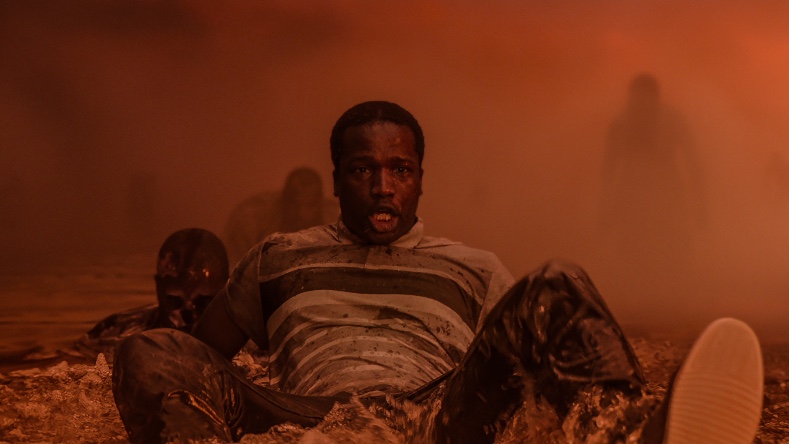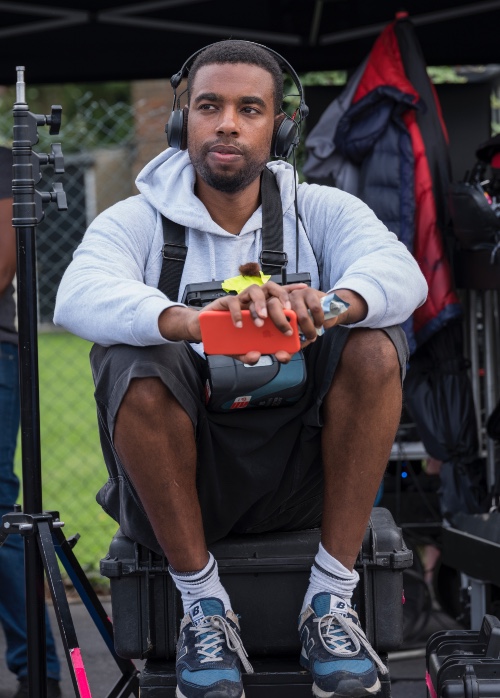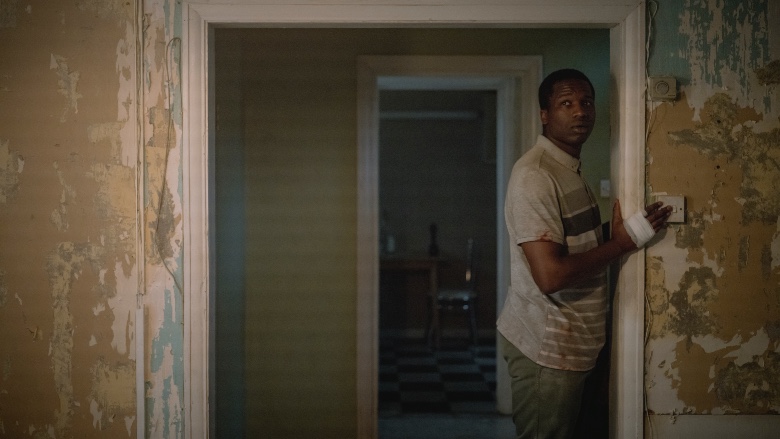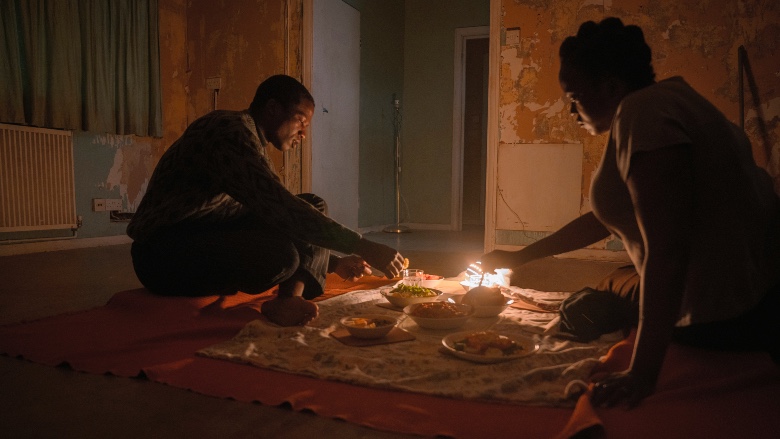
2020 has been a great year for new talent to have their smaller films seen by much larger audiences, mainly because a lot of the studio films have been delayed or yanked or sent directly to streaming. In fact, streamer Netfix has certainly done its share of shining the spotlight on this new talent this year, and British filmmaker Remi Weekes was lucky enough to get a pre-Halloween release for his debut feature, His House, because it is indeed a horror film.
It stars Sope Dirisu and Wunmi Mosaku as Bol and Rial Majur, East African refugees seeking asylum in the UK where their attempts to acclimate and adjust to their new world is plagued by an evil that inhabits their new home.
His House is a film with true vision that shows Weekes working with an amazing team of creatives to create the eerie tone and terrifying scares within his first feature film.
Below the Line got on the phone with the young filmmaker last week for the following interview:

Below the Line: I know this is your first feature, so how did it come about?
Remi Weekes: Before this, I had been doing short film and commercials and what-not, and some producers asked me if I would pitch them my take on immigrant horror. I pitched them what’s in the movie, which was an intimate two-hander psychological story about two people trying to move on from their trauma, trying to survive after surviving. They liked it, and I wrote it, and then we went and made it.
BTL: That sounds surprisingly easy. What were some of the influences for this story? Did you have to do any research for some of it?
Weekes: Yeah, we did a lot of research. We were researching the asylum-seeking process and then first-hand asylum seekers, their stories, but we also research the migration process from Africa to Europe. Aside from that, I also drew from personal experience. I grew up in London, from quite a diverse communities and our experiences in the UK and our feelings towards assimilation and trying to fit in.
BTL: Was it hard to find the two leads? Did you work with a casting director?
Weekes: Yeah, we worked with Carmen Cuba, who is a casting director, and we did a really broad search. It was very serendipitous one day, our producer mentioned Sope, and so we tried to see him and tried to get him, and then the same day, Wunmi, who doesn’t live in the UK anymore was in town by chance, and someone recommended she come in, so she came in, and they both performed together. The chemistry was so good, that it was an immediate decision.
BTL: You also got Matt Smith to play a small role, and I didn’t even recognize him when he was showing them the home. How did you get him to play that role?
Weekes: I guess he just happened to read the script and really liked it, and asked to be involved in it, and of course, we said, “Yes.”
BTL: It sounds like everything about this movie really came into place fast. Is that the case or did it still take a long to get it going?
Weekes: I’m probably skipping over the rough terrain on this journey. It took a lot of work to make this film, but I feel like it came together.
BTL: I’ve spoken to many filmmakers, even established ones, who need to spend a decade or more getting a movie they want to make rolling, so a couple years is pretty good.
Weekes: Yeah, tell me about it.
BTL: One of the most important things after the cast is the location and that house. Was that mostly constructed on a soundstage or did you find a location in which you could shoot?
Weekes: We found a location called Tilbury, which is in Essex, and then we filmed in the house for a couple of days, and then we recreated the house on the soundstage in West London and shot the rest of interiors in there.

BTL: Can you talk about working with your production designer to create the look for the interiors of the house which change and evolve so much, and add so much to the tension?
Weekes: Yeah, it was really cool. It was important for us to tell a story with the interiors. Working with Jacqueline, the Production Designer, even though we’re spending time almost all in one location, we wanted to use the location as a character and have it reflect where the characters were during the journey of the film. It was really exciting for us to find ways, especially with the wallpaper and under the wall to reflect back on the characters.
BTL: Did you shoot all the interiors first or the exteriors?
Weekes: We shot the exteriors first, I think. We sent the first few weeks on location, and then we moved into the studio.
BTL: There’s also some stuff set in Africa, so where did you shoot that stuff? Did you find a place in England to create that?
Weekes: We shot in Africa, we shot in Morocco.
BTL: What was it like working with those crews?
Weekes: It was wild and a lot of fun, and it was crazy being on a set where people were speaking English, French, Arabic, Dinka… It was tough for the first AD, but it was a really great experience.
BTL: How much time did you end up spending there to film those scenes?
Weekes: We were there for a week.
BTL: I really liked the look of the movie, and it feels like you did a lot of the scarier stuff on set and in camera, so can you talk about working with the DP and crew to create that look?
Weekes: Yeah, we did. We tried to get everything in camera. It was important to us to use in-camera techniques as much as possible. That was definitely a choice that we made.
BTL: When building the set on the soundstage, you have a lot of different-looking areas, and a lot of the effects looks like they were built into the walls and floors.
Weekes: When we were on the soundstage, we were really able to utilize the sets to break things up and really use our imaginations.

BTL: But there’s some stuff that had to be done with visual FX, like the nightmare sequence, which would be hard to create. There must have been a lot of planning for that, too, so was there a lot of green screen particularly for that sequence?
Weekes: That specific sequence… yes, there’s so much planning for every film. We storyboarded everything. That particular sequence, we built a huge but very shallow tank of water in the studio, and then we placed the kitchen wall into the middle of the tank and used that as the ocean and then digitally extended the ocean in post-productions, and that’s how we did it.
BTL: Going back to the origins of the movie, are a lot of the things in the movie actual myths or legends, or was a lot of it made-up?
Weekes: It’s based on real Dinka folklore that we researched during the making of the film.
BTL: Music and sound design also plays an important role in the tone of the movie and the tension, so who did you work with? Were you working with new people or those you’ve worked on some of your previous shorts?
Weekes: It was all new people, being my first film. The studios felt more secure if I was working with people who are more experienced than I was. When I was doing my shorts and what-not, it was more about using the people you know and your friends, but when you go into [a studio movie] you use professionals. The music was composed by Roque Baños, he’s a Spanish composer.
BTL: Was he involved fairly early on even before you started shooting or was he brought in after you did an edit?
Weekes: He came in after during the editing process.
BTL: Did he work closely with sound design to incorporate those elements or was that all handled in the mix?
Weekes: It was a bit of long process of trying stuff out, trying and failing and building stuff while we’re editing, and trying out new sounds. It was a really fun process.
BTL: Were you generally a horror fan before tackling this project? Were they an influence on you as a filmmaker?
Weekes: I mean, I love horror and cinematic spectacle. I love Kubrick, I love Hitchcock, and I love big, traditional filmmaking – it always excites me.
BTL: But working with the composer, you didn’t go for that big typical over-the-top horror sound, and it’s almost minimalist at times with a lot of quiet moments.
Weekes: No, I guess it was important to us to use a real mix of Western stuff, but also East African township stuff, so it was less so much of the more traditional classic Western score.
BTL: I know this played at Sundance, but have you had a chance to see the movie in other places than there and England?
Weekes: No, I haven’t.
BTL: But you had it completely finished for Sundance or did you do any more post afterwards?
Weekes: We were able to finish it just before [Sundance] luckily.
BTL: Have you started thinking about what you want to do next?
Weekes: No idea. I’m still in the process of exploration and discovery right now.
Weekes’ film, His House, is now streaming on Netflix.





